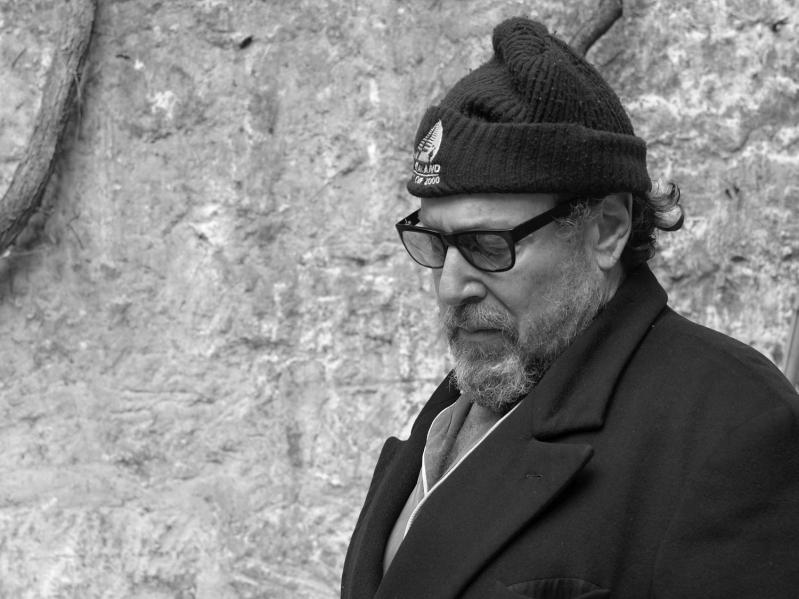Julian Schnabel established himself as one of the leading painters of his generation in the late 1970s through his use of unconventional materials, varied painting surfaces, and inventive modes of construction. Sustaining that career at a high level for more than 40 years would be enough of a challenge for any artist.
It's fair to say that to couple that with a film career that spans almost 30 years and includes a best director Academy Award nomination, for "The Diving Bell and the Butterfly," puts him in a class by himself.
Mr. Schnabel's career is to be the subject of two celebrations in August. "Julian Schnabel: Selected Works From Home," which features paintings, drawings, and sculptures from the artist's personal collection, will open at Guild Hall on Sunday. Guests at Guild Hall's summer gala will be able to preview the exhibition Friday night, and members can do so on Saturday,
The Sag Harbor Cinema is presenting another Schnabel show, a retrospective timed to run concurrently with Guild Hall's, called "Portrait of the Artist: Julian Schnabel and Film." It will open next Thursday at 6 p.m. with a sneak preview of a newly restored version of his first film, "Basquiat" (1996), which starred a 20-year-old Jeffrey Wright as the legendary painter. A question-and-answer session with the filmmaker will follow the screening.
The works on view at Guild Hall, made over the past 45 years, include an early wax painting, "Procession (for Jean Vigo)" from 1979; "Salinas Cruz," a 1984 painting on velvet; paintings on printed materials and tarpaulins, and multiple plate-paintings, which show the artist's various approaches to that material over decades.

"When we first started talking with Julian about this show, he invited us to his home in Montauk and took us around," said Melanie Crader, Guild Hall's director of visual arts and curator of the exhibition, during a conversation at the cultural center. "One of the things I love that he always says is that he lives among his work, but he also lives among other artists’ work."
Most of the works in the exhibition come from the artist's home in New York City, but there are several pieces from Montauk. "It’s work he’s chosen to keep and live among, and I think that’s what’s really special about it," said Ms. Crader. "It’s also really generous that he’s sharing this work with us."
Noting that Mr. Schnabel has been a constant in contemporary art discourse since his first show in 1979, she cited as one source of his "revolutionary force" the idea that "he has no hierarchy about painting or work. Whether it's content or materials, all of those things are in play. What I find fascinating is how much freedom that has given him. And I think you see that in his work."
According to Max Hollein, the director of the Metropolitan Museum of Art and author of two books about Mr. Schnabel, "Emerging from an American artistic tradition that deliberately challenged reigning ideas of surface and form in paintings, since the late 1970s the artist has sought to transform the realities and possibilities of the medium: what a painting is, what it can be, and how it can be done."
"A Conversation With Julian Schnabel" will take place at Guild Hall on Saturday at 6 p.m.
The Sag Harbor Cinema will screen all of Mr. Schnabel's films, as well as a program of international films selected by him that have influenced his own work.
"Basquiat" starred, in addition to Mr. Wright, David Bowie as Andy Warhol, Dennis Hopper as the art dealer Bruno Bischofberger, Gary Oldman as a Schnabel-like composite character, and Parker Posey at the gallerist Mary Boone, as well as Christopher Walken, Willem Dafoe, Courtney Love, and Tatum O'Neal.
The retrospective will also include "Before Night Falls" (2000), which stars Javier Bardem as Reinaldo Arenas, the Cuban poet; "The Diving Bell and the Butterfly" (2007), "Lou Reed: Berlin" (2007), "Miral" (2010), and "At Eternity's Gate" (2018), with Mr. Dafoe as Vincent Van Gogh.
"Each of Julian Schnabel’s films is a world of its own," said Giulia D'Agnolo Vallan, the cinema's founding artistic director. "None is like the one before or the one after. Yet it is not a coincidence that most of them are portraits of artists and passionate depictions of the artistic process. As we look forward to his new feature, 'In the Hand of Dante,' it is a joy to be able to bring this retrospective to our audience."
Mr. Schnabel's curatorial selections include Mikhail Kalatozov’s "I Am Cuba" (1964), as well as Pier Paolo Pasolini’s "Accattone" (1961), Andrei Tarkovsky’s "Andrei Rublev" (1966), Elem Klimov’s "Come and See" (1985), François Truffaut’s "400 Blows" (1959), and others to be announced through the year.
In conjunction with the screenings, an exhibition of art and artifacts from Mr. Schnabel's films will be on view on the cinema's third floor.




